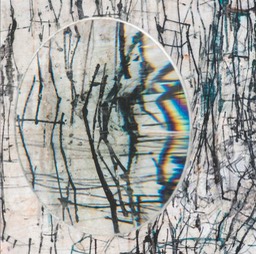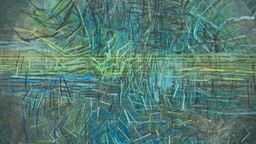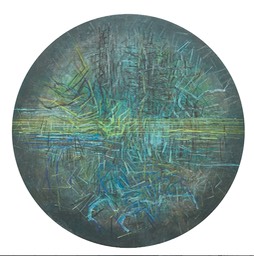At MOCA North Miami: The world according to Carlos Salas
BY GEORGE FISHMAN
george@QRartguide.com
This winter, South Floridians can explore the work of one of Colombia’s most respected artists without leaving home, at North Miami’s Museum of Contemporary Art.
During a 2012 visit to Colombia, MOCA director Babacar M’Bow was struck by the vigor and originality of the abstract compositions of Carlos Salas, a vaunted painter who, in 1999, at 42, earned a retrospective at Bogotá’s Museum of Modern Art (MAMBO). M’Bow was also impressed by Salas’ role as a public intellectual who maintains an active written critique of politics.
Though M’Bow’s own political views differ from those of Salas, the artist’s approach complemented M’Bow’s vision for MOCA as a vehicle for questioning norms and sparking social transformation rather than “simply producing things that are beautiful to hang on the wall,” as M’Bow puts it.
During the past year, until his recent administrative leave for alleged office misconduct, M’Bow and then-assistant director of education Adrienne von Lates created experimental exhibitions aimed at disrupting common museum practice to present alternative viewpoints. In particular, they engaged local artist-curators, curried connections with the museum’s largely Haitian-American neighborhood and sought alternatives to the default North America-Europe artistic corridor. (Von Lates has since left the museum.)
Rather than just importing Salas’ second MAMBO retrospective that covered the years 1999-2014, M’Bow and Salas focused on work from the past five years — a crucial period for the artist, when he underwent the sobering ordeal of diagnosis and treatment of leukemia.
The keynote of the exhibition is a nearly 10-foot-diameter circular panel, titled Into the Abyss. This complex, multilayered painting epitomizes Salas’ complex work process, captured in his daughter’s documentary film Into the Studio, which premiered at MOCA during Art Week earlier this month. The painting embodies a ritualistic but sometimes seemingly capricious work flow in which he alternately creates, obscures and reveals the centrifugal dynamic of his composition. Working the panel at times vertically and then laying it on the floor to pour and then harshly scrape paint, Salas masks areas with tape, brushes, scrubs, scores with a hot soldering iron — and then repeats the whole procedure. The process entails both well-honed technique and an improvisational response to each momentary state of mind and paint. “This,” he says at one point in the film, “is when you feel like the painting’s servant, not the one in charge or in command.”
The film is based on 45 days of recording in Salas’ Bogotá studio and includes the artist’s solo ruminations, thoughtful dialogues with Ana, mundane household activities and, most critically, his varied handling of painting. The unflinching documentary and the lavishly produced catalog of essays, letters and images provide welcome context for the exhibition of 60 abstract artworks that will likely mystify many museum-goers. Even loyal patrons of MOCA will be startled to find the main gallery stripped to its skeleton by Salas’ bare-bones approach to the museum’s gallery space. “MOCA was already in a process of metamorphosis,” he said. This condition provided a rationale and opportunity for radically transforming the space. “Remove the walls; open the windows,” he requested.
And it was done.
The staging of this complex exhibition is vital and dramatic. The show begins chronologically with a 2010 series of paintings called Traces of Feeling that hang in an alcove of the main hall. Their palette led a friend to ask the artist, “Did you paint them in blood?” Salas was puzzled but a few months later received his diagnosis of the now-arrested blood disease. He explained that his body subconsciously expressed awareness of the illness, before he was mentally cognizant of it. “My body painted for me,” he said. Three large rectangular canvases hang on the walls and two are suspended back-to-back to separate a niche-like enclosure from the main exhibition hall. This intimate encounter then launches the remainder of the show.
The principal space is divided, like a streamlined Gothic cathedral, into a main longitudinal axis and side aisles, delineated on one side by columns. Into the Abyss, the focus of the documentary, holds a privileged viewing position. Pairs of large paintings are suspended crossways to form a walkable labyrinth, with each pairing representing a thematic story episode while also mirroring Salas’ Bogotá studio.
Salas’s work has been influenced by ideas about the power of dreams, myths, archetypes and the collective unconscious espoused by 19th century psychologist Carl Jung and mythologist Joseph Campbell. Some of this probing of motivation, memory and circumstance can be read in the poetic, introspective texts and titles that serve as signposts through the exhibition. Music ranging from Bach’s complex harpsichord compositions to contemporary “world music” by Stephan Micus plays throughout the space, underscoring Salas’ intrigue with connecting inner and outer worlds and his ongoing embrace of the “theme and variations” form.
Taken together, the presentation questions mankind’s imperiled global stewardship — an approach that reflects M’Bow’s own views. “How do we really seriously engage this painful human striving for a world not as it is, but as it could be?” M’Bow asked in a recent interview. He sees in MOCA, “the construction of a space where our political ideology is no longer relevant when we enter that space.” Salas clearly agrees. As he wrote in a recent blog post, “Art is a refuge where we can feel protected from the continuous demands of everyday life, but it also gives us a wake-up call to counteract our negligence of what’s essential.”
One extensive series in the exhibition is called A Sharp Dagger. It includes notebooks and painted-over magazines, photographs, drawings and texts. It is dedicated to exiled Hungarian composer György Ligeti, whose staccato musical notes he likened to plunging a knife into the heart of Stalin. Continuing the Dagger series, Salas engraved round metal plaques with Latin texts, mounted on stands. “These are fragments of what I write every week on Colombian politics.” He finds much to criticize.
Throughout his career, Salas has pursued an interest in optics and history. The result is an intriguing visual matrix. Suspended lenses magnify sections of his drawings, hung together in rack. Eighteen large square photographs, mounted on a nearby wall, freeze and flatten those three-dimensional juxtapositions.
Another series, Fragments of an Old Painting, is the “residue” of a large painting whose collector brought it to his seaside home 30 years ago, where it was damaged by humidity. When the work was returned to the studio in Bogotá, Salas cut the canvas into 25 segments and eventually reworked and reassembled them. While the works are satisfying as independent compositions, many seem to bear the scars and indentations of their tribulations. By reconfiguring the original composition, (Salas permits multiple assemblages), the arrangement questions the fundamental process of creating and assessing a composition. It also evokes the theme of impermanence vs. eternity. What will remain of our presence here on Earth? What are we doing with that Earth?
In yet another grouping, six large round paintings are hung high, with a line of the variously sized painted books projecting from the wall below them. “I wanted to have an exhibition that would be clean, but polluted,” said Salas. “Full, as if I were discharging my brain into the exhibition.” That’s an apt description for the overall show, filled with numerous ideas, styles and formats that challenge the viewer.
Still, the show feels coherent, clearly reflective of Salas’ singular point of view. Whatever his principal palette choices for a given series — golden hues or deep oceanic blue-greens — the works conjure softly nuanced volumetric spaces. An underlying grid is sometimes visible beneath multicolored drips, streams, blotches, meandering lines, stains and clusters of linear incisions — even snapped chalk lines. Like calligraphy or musical notation, these constitute Salas’ distinctive language of mark-making and provide a complex rhythmic punctuation that weaves across the often diaphanous veils of thinner paint.
Abstract art may not reflect our familiar visual world, but almost inevitably it conveys the artist’s interior landscape and emotional state, whether lyrical, vengeful, melancholy, searching or jubilant. “The challenge of painting is to clear away the surface in order to unveil the unseen,” said Salas. In this regard, the exhibition Carlos Salas: Latin America and the Global Imagination confirms the notion that the universal is most keenly expressed through the intensely personal.


